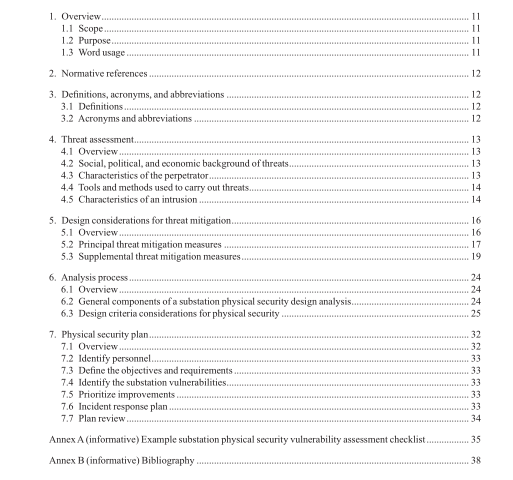IEEE 1402-2021 pdf download.IEEE Guide for Physical Security of Electric Power Substatons
4. Threat assessment
4.1 Overview
Threats to substations can arise in many different forms. Threats can come from both outside and inside an organization that designs, builds, operates, and maintains a substation; they also be driven by location, be intentional (planned) or opportunistic, be disruptive to operations, or simply be vandalism or theft. Effective substation security starts with first acknowledging and evaluating the potential threats to a substation. This clause assesses some common threats to substations; other threats are possible and should be assessed to determine whether mitigations are needed to minimize those threats. For more on threat assessment and security plan development see Clause 7 of this guide. Threats to assets and operations due to natural forces, poor asset management, human error, etc., are beyond the scope of this guide.
4.2 Social, political, and economic background of threats Threats to substations are typically associated with some form of motivation that drives individuals to attempt to compromise a substation or its operations. Subclauses 4.2.1 through 4.2.4 discuss several typical factors that can lead to threats. 4.2.1 Economic According to a 2010 US Department of Energy report [B15], the major factor directly influencing copper theft from utilities is the price of copper.
4 As the price of copper increases, copper thefts rise. Some of the other factors influencing the rates of copper theft include drug use, proximity to scrap dealers, population density, unemployment, and poverty.
4.2.2 Substation location The location of a substation can contribute to increased risk for threat, particularly vandalism and theft (primarily of copper and aluminum) due to being located in higher crime areas or due to the remoteness of the substation. Utilities may choose to review the history and level of illegal activity of the area in which a substation is located and plan accordingly, especially during construction activities when tools and materials are used or stored on site.
4.2.3 Political or labor unrest Political unrest can be very unpredictable in its occurrence and focus. Substations can be either the target of or collateral damage from acts of sabotage, vandalism, riots, civil disobedience, and protests. Similarly, labor unrest within substation’s owners and operators by workers or contractors may provide the impetus for possible retribution by damaging assets or disrupting normal operations at substations.
4.2.4 Disgruntled employees Current and former employees and contractors can be a particular threat because of their insider knowledge of the electrical system and operating procedures. This is of particular concern as such employees or contractors could take action while they still have access to a substation.
4.3 Characteristics of the perpetrator Understanding the human aspects of threats supports better security designs. The following are some factors to consider:
— Means of access: Perpetrators can attempt to gain access by scaling walls or fences, crossing moats, breaking down physical barriers, etc.
— Intentional, not accidental: Most threats that would signifcantly impact the assets or operations of a substation are deliberate in nature. Vandalism may be more spontaneous (e.g., crime of opportunity), but nonetheless also deliberate.
— Not authorized: Threats and actions may be caused by non-employees, contractors, or non-authorized employees and thus are individuals who are not authorized to be within the substation. These individuals would need to breach physical security to gain access or generate damage from outside the physical perimeter security.
— Disgruntled former/current employee: Current and former employees and contractors can be a particular threat because of their insider knowledge of the electrical systm and operating procedures.
4.4 Tools and methods used to carry out threats There are various means that can be used to attempt to carry out a threat. These can include more traditional tools as well as cyber methods. For more on cybersecurity, see IEEE Std C37.240™ [B11]. Some tools and methods used to carry out threats are as follows:
— Vehicular: Many types of vehicles can be used to attempt to breach perimeter security. Frequently, trucks (pickups, fatbeds, and other large delivery trucks) can be used to knock down, pull down, or otherwise open gates or sections of walls and fencing. Other vehicles can include construction equipment (e.g., backhoes) and defense (army) vehicles.IEEE 1402 pdf download.IEEE 1402-2021 pdf download
IEEE 1402-2021 pdf download

Leave a Reply